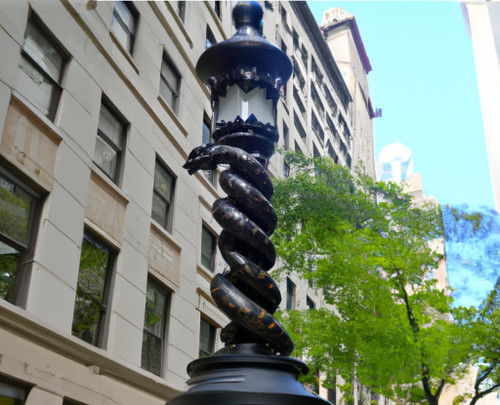Bollard Lighting
Commercial bollard street lighting
Refers to the lighting fixtures installed on bollards, which are short, sturdy vertical posts typically made of metal or concrete. Bollard lights are commonly used in commercial areas such as streets, parking lots, walkways, and outdoor spaces to provide illumination, enhance visibility, and improve safety. There are several types of commercial bollard street lighting available, including:
1. Traditional Bollard Lights: These are the most common type of bollard lights and are characterized by their classic design. Traditional bollard lights often feature a cylindrical or square shape with a single light source at the top. They provide functional lighting and are available in various heights, styles, and materials to complement different architectural settings.
2. Contemporary Bollard Lights: Contemporary bollard lights feature sleek, modern designs that blend well with contemporary architectural styles. They often incorporate innovative materials such as stainless steel, aluminum, or glass, and may have geometric or abstract shapes. Contemporary bollard lights focus on both functionality and aesthetics, offering a visually appealing lighting solution.
3. Solar-Powered Bollard Lights: With a growing emphasis on sustainability and energy efficiency, solar-powered bollard lights have become increasingly popular. These lights are equipped with photovoltaic panels that harness solar energy during the day, storing it in built-in batteries. They can then illuminate the surroundings using this stored energy during the night, without the need for a direct electrical connection. Solar-powered bollard lights are an environmentally friendly and cost-effective option.
4. LED Bollard Lights: Light Emitting Diode (LED) technology has revolutionized the lighting industry due to its energy efficiency, long lifespan, and versatility. LED bollard lights use LED bulbs, which consume less energy compared to traditional lighting technologies, while providing bright and focused illumination. LED bollard lights are available in various designs, colors, and brightness levels, allowing for customization and energy savings.
5. Smart Bollard Lights: The advent of smart technology has extended to bollard lights as well. Smart bollard lights are equipped with sensors, wireless connectivity, and control systems that allow for remote monitoring and management. These lights can be programmed to adjust their brightness levels, detect motion, respond to ambient light conditions, and communicate with other smart devices. Smart bollard lights offer enhanced energy efficiency, improved safety features, and advanced lighting control capabilities.
It's important to note that the availability of these types of commercial bollard street lighting may vary based on manufacturers and specific project requirements. When selecting bollard lights for a commercial setting, factors such as lighting requirements, aesthetic preferences, energy efficiency, durability, and maintenance should be considered to ensure the chosen lighting solution meets the intended needs.
Materials Used For Commercial Bollard Lighting
Commercial bollard street lighting fixtures are constructed using various materials, chosen for their durability, aesthetics, and resistance to environmental conditions. Here are some common materials used in commercial bollard street lighting:
1. Metal: Metal is a popular choice for bollard construction due to its strength and durability. Common metals used include stainless steel, aluminium, and cast iron. Stainless steel is particularly favoured for its corrosion resistance and modern aesthetic appeal. Aluminium is lightweight, corrosion-resistant, and easily shaped, making it a versatile option. Cast iron is known for its classic and traditional look, and it offers excellent durability.
2. Concrete: Bollards made of concrete are sturdy and long-lasting. They are typically reinforced with steel for added strength. Concrete bollards can be plain or textured, and they are often used in areas where durability and security are paramount.
3. Glass: Glass bollard lights provide a modern and sleek appearance. They are often used in contemporary architectural settings to create an elegant and sophisticated look. The glass used is typically toughened or tempered for increased strength and safety.
4. Composite Materials: Bollard lights made from composite materials combine different elements to create a lightweight and durable product. These materials often consist of a mixture of polymers, fiberglass, and additives. Composite bollard lights can mimic the appearance of other materials such as wood or stone while offering superior resistance to weather and UV radiation.
5. Polycarbonate: Polycarbonate is a strong, transparent plastic material known for its impact resistance. It is often used for the light diffusers or lenses in bollard lights, providing protection to the light source while allowing the light to pass through.
The choice of material depends on various factors such as the intended use, environmental conditions, desired aesthetics, and budget considerations. Each material has its own advantages and can be selected based on the specific requirements of the commercial bollard street lighting project.
What considerations to take into account when designing and installing commercial street bollard lights:
When designing and installing commercial street bollard lights, several considerations should be taken into account to ensure optimal performance, functionality, and aesthetics. Here are some key considerations:
1. Lighting Requirements: Determine the specific lighting requirements of the area to be illuminated. Factors such as desired light levels, beam spread, color temperature, and light distribution should be considered. The lighting design should be tailored to meet the specific needs of the space, whether it's for general illumination, accent lighting, or safety and security purposes.
2. Regulations and Standards: Familiarize yourself with local regulations, standards, and guidelines regarding outdoor lighting installations. These may include requirements for light pollution control, energy efficiency, uniformity, glare reduction, and safety. Compliance with these regulations ensures that the bollard lights meet the necessary criteria and contribute to a well-lit and safe environment.
3. Placement and Spacing: Carefully consider the placement and spacing of the bollard lights. Factors such as the width and layout of the street, pedestrian pathways, and architectural features should be taken into account. Proper spacing ensures uniform illumination and avoids dark spots or overly bright areas. Additionally, consider the placement of bollards to provide adequate clearance for pedestrians, vehicles, and other objects.
4. Power Source: Determine the most suitable power source for the bollard lights. Options include direct electrical connection, solar power, or a combination of both. Consider factors such as availability of electrical infrastructure, cost-effectiveness, sustainability goals, and maintenance requirements when selecting the power source.
5. Material and Design: Choose materials and designs that are durable, weather-resistant, and aesthetically pleasing. Consider the surrounding architectural style and select bollard lights that complement the overall design. The material should withstand outdoor conditions, such as UV exposure, moisture, and temperature fluctuations, to ensure long-term performance.
6. Maintenance and Accessibility: Consider the maintenance requirements of the bollard lights. Choose fixtures that are easy to access for maintenance tasks such as bulb replacement or cleaning. Consider features like quick-release mechanisms or hinged access panels that facilitate easy maintenance while ensuring safety.
7. Safety and Security: Incorporate safety features such as impact resistance, anti-vandalism measures, and proper illumination of critical areas. Consider factors such as visibility, light levels, and the prevention of glare to enhance pedestrian and vehicular safety.
8. Environmental Impact: Consider the environmental impact of the lighting installation. Opt for energy-efficient lighting technologies such as LED bulbs and consider incorporating smart lighting controls to minimize energy consumption. Additionally, consider the use of sustainable materials and practices during installation.
By carefully considering these factors, you can design and install commercial street bollard lights that meet the specific requirements of the space while providing efficient, safe, and visually appealing illumination.
Famous Street Bollard Lights
While individual bollard lights may not be widely recognized as famous in the same way as iconic landmarks or sculptures, there are several notable street lighting installations that have gained recognition for their design, innovation, or historical significance. Here are a few examples:
1. Illuminated Bollards, Las Vegas, USA: The Las Vegas Strip is known for its vibrant and extravagant lighting displays. Illuminated bollards are a common feature along the Strip, showcasing a wide variety of creative and colorful lighting designs. These bollards contribute to the overall visual spectacle and help create the iconic nighttime ambiance of Las Vegas.
2. Harbour Bollard, Sydney, Australia: Located along the waterfront of Circular Quay in Sydney, the Harbour Bollard is a prominent public artwork. Created by artist Jennifer Turpin, the bollard is topped with a solar-powered light and incorporates elements of sculpture and design. The artwork has become a recognizable symbol of the Sydney Harbour precinct.
3. Tate Modern Bollards, London, UK: The area surrounding the Tate Modern art gallery in London features a distinctive installation of bollard lights. Designed by artist Lutz Becker, these bollards are illuminated with embedded LED lights, creating an immersive and visually striking experience. The installation adds an artistic element to the street lighting while enhancing the overall ambiance of the area.
4. Gaslamp Quarter Bollards, San Diego, USA: The Gaslamp Quarter in San Diego is a historic neighborhood known for its Victorian architecture and vibrant nightlife. The bollard lights in this area are designed with ornate ironwork and traditional aesthetics, reflecting the historic character of the district. These bollards contribute to the unique atmosphere of the Gaslamp Quarter.
5. The Bollards of Amsterdam, Netherlands: Amsterdam is known for its charming canals and picturesque streets. The city's bollards, known as Amsterdammertjes, are a recognizable feature of the urban landscape. These tall, red bollards are found throughout the city and serve as both traffic management and historical symbols of Amsterdam's identity.
While these examples showcase notable bollard lighting installations, it's important to note that bollard lights often blend into the overall urban environment and may not receive individual recognition. However, their collective presence contributes to the overall aesthetic and functionality of the streetscape.

